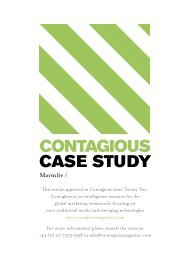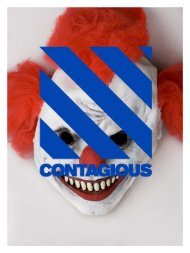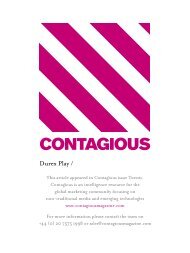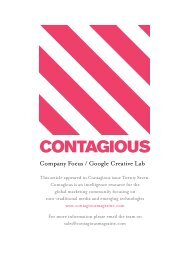CASE STUDY Uniqlo - Contagious Magazine
CASE STUDY Uniqlo - Contagious Magazine
CASE STUDY Uniqlo - Contagious Magazine
You also want an ePaper? Increase the reach of your titles
YUMPU automatically turns print PDFs into web optimized ePapers that Google loves.
and map / uniqlo /<br />
00<br />
UQ<br />
01<br />
RE-<br />
THINK<br />
01<br />
COLLA-<br />
BORATE<br />
UQ<br />
UNIQLO / BRAND MAP /<br />
01<br />
804 STORES<br />
01<br />
UNI-<br />
SEX<br />
01<br />
01 / RECRUIT & REJUVENATE /<br />
REJUVENATE<br />
<strong>Uniqlo</strong> is Japan's leading unisex clothing<br />
chain, with 804 stores and a 2008 net<br />
sales forecast of ¥585bn (€3.5bn).<br />
Shares in its parent, Fast Retailing reported<br />
a five-year record high of ¥12,110 (€71.7)<br />
in July.<br />
This scenario certainly wasn't predicted<br />
after a failed expansion into the UK in<br />
2001. <strong>Uniqlo</strong> had high expectations of its<br />
European launch, but was met with<br />
consumer indifference – largely because<br />
of a 'scattergun' approach to retail<br />
locations, the lack of a flagship store<br />
and minimal marketing activity in the key<br />
territory of London. This retreat forced<br />
the brand into a rethink, embarking<br />
upon a more collaborative approach to<br />
its identity and marketing that has since<br />
sparked a global success story. Rather<br />
than using a single agency, key figures<br />
(Kashiwa Sato, Markus Kiersztan¸ Yugo<br />
Nakamura, etc) from numerous creative<br />
disciplines, were recruited to rejuvenate<br />
every aspect of the <strong>Uniqlo</strong> brand, from<br />
store design to its digital presence.<br />
02<br />
SERVICE-<br />
DRIVEN<br />
02<br />
IN-STORE<br />
GALLERY<br />
02<br />
NYC<br />
02<br />
BASIC<br />
02<br />
CONTAINERS<br />
The UNIQLO brand philosophy has always<br />
been about creating a distinctly utilitarian,<br />
service-driven retail experience to reflect<br />
the basic prices but premium product<br />
quality. Prior to the 2006 opening of its<br />
global flagship store in Manhattan's fashion<br />
district, several shipping containers were<br />
hoisted into selected locations around<br />
NYC to serve as temporary outlets – the<br />
neatly folded stacks of clothing promoting<br />
the utilitarian perfection preached by<br />
the brand. Once the real store opened,<br />
the 36,000 square foot space showed a<br />
deliberate juxtaposition between the<br />
brand's Japanese heritage and a<br />
contemporary, culturally inclusive retail<br />
experience.<br />
After the lessons learned in London, this<br />
strategy shows that UNIQLO now<br />
approaches each new market tentatively<br />
and looks to gain a solid understanding<br />
prior to large scale-commitment. With<br />
plans already in place for Paris and<br />
Singapore, the company aims to triple<br />
its turnover in the next four years.<br />
03<br />
UNIQLO<br />
PAPER<br />
02 / UTILITARIAN & UNIQUE / 03 / PAPER & PLASTIC /<br />
03<br />
UT<br />
03<br />
PLASTIC<br />
TUBES<br />
02<br />
MP<br />
CREATIVE<br />
03<br />
STREET-<br />
CAST<br />
Aligning the brand with the art and design<br />
industry, the UNIQLO Paper is a free<br />
in-store and online magazine conceived<br />
by MP Creative. 'More than a look-book',<br />
it features interviews with designers,<br />
local celebrities and artists to emphasise<br />
the brand's cultural relevance.<br />
An in-store gallery exhibited a range of<br />
100 limited-edition T-shirt designs from<br />
40 artists including Yayoi Kusama, Tezuka<br />
and Godzilla. This space was later used<br />
to house the first foreign installment of<br />
the brand's UT Campaign. Based on the<br />
successful UT Store in Tokyo this distinctly<br />
Japanese retail device sells limited-edition<br />
T's packaged in plastic tubes, providing<br />
a self-service system that is more<br />
convenience store than fussy fashion<br />
retailer. The campaign was supported by<br />
print, poster and in-store ads, featuring<br />
portraits by Terry Richardson. In spring<br />
2008, the project launched on a global<br />
scale with Matt Irwin shooting 300 streetcast<br />
models in Tokyo, NY and London.










